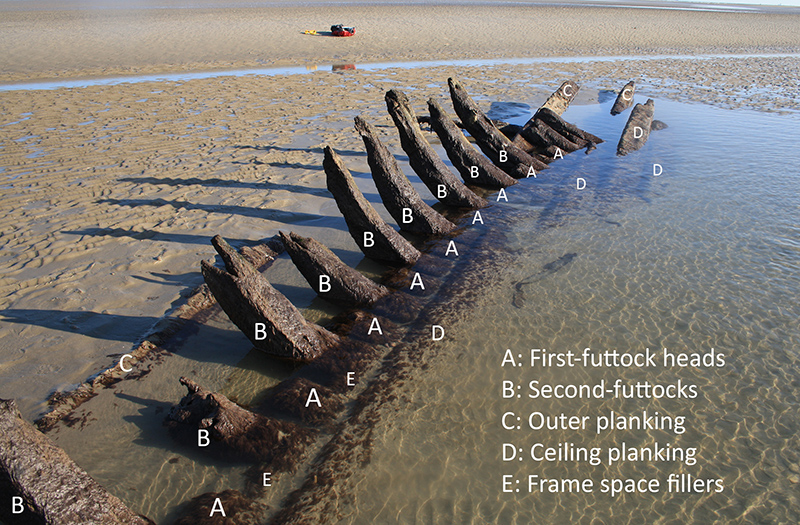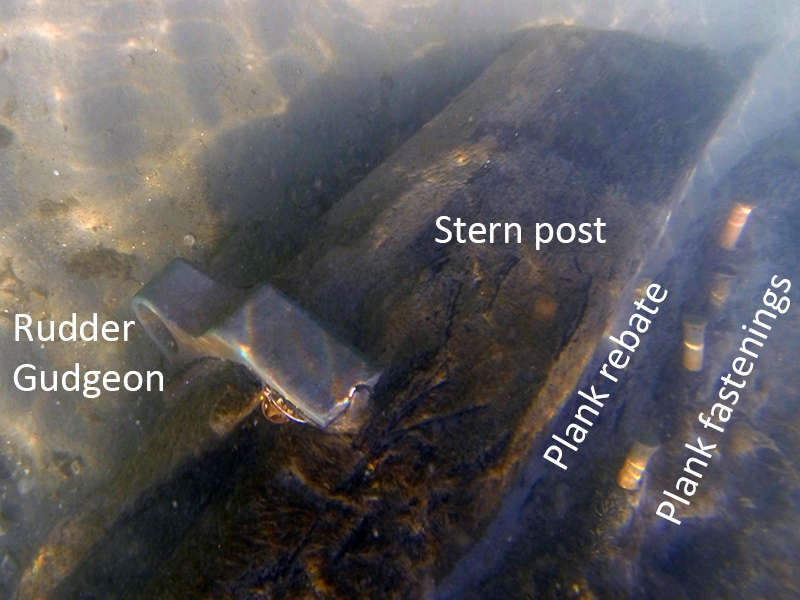
In January 2014, the southern coast of England experienced a period of severe winter storms. In the aftermath, we received a report from a member of the public about the appearance of a previously unknown shipwreck on the East Winner bank, located at the south-west corner of Hayling Island, in the eastern Solent. Initial photographs revealed much of the port side of a large wooden vessel had been exposed.
Given the transient conditions at the site—uncovered by extreme weather and lying in an inter-tidal zone vulnerable to sediment fluctuations—a swift response from us was vital. During two visits in April, we assessed the well-preserved set of remains, over 20m in length with the stern post, a rudder gudgeon and a large part of the portside of the vessel still intact. This wooden sailing vessel, built in a frame-based carvel tradition, most likely dates from the early-19th century.

Because the wreck lies at the interface between land and sea, excavations could only be carried out during a short window of about forty-five minutes at low-water spring tides. Even then, much of the vessel remains underwater. We worked against the clock to achieve a limited set of objectives, including documenting characteristics and creating an extensive photographic and video record. Dimensions and constructional features had to be prioritised over a traditional site plan.
The massive impact of the winter storms soon became evident. Sediment movement along the eastern edge of the sand back had rerouted a drainage stream, resulting in the scouring out and exposure of the wreck. This shift appears to be unprecedented in recent decades. The wreck is not marked on any charts, and conversation with local residents indicated that the wreck has not been visible during the last forty years.
The remains themselves are extensive and began to paint a significant picture of the vessel. It is aligned on a north-south axis with the stern post of the vessel at the northern end, and has no evidence of mechanical propulsion. The frames are oak. The extant elements are first and second-futtocks in the southern area of the site, originally fastened together with iron bolts, of which only the bolt holes remain. The port quarter has collapsed outward and retains the first to third-futtocks and the top-timbers, adjacent to the degraded stern post and a single surviving rudder gudgeon. Other features identified included outer planking and ceiling planking fastened with wooden treenails. A partial beam, dislocated from its original location, was found in the middle of the site with the remains of an iron knee at one end.

Identifying the Wreck
Identifying an exact date for the vessel is difficult. The iron knee, coupled with the use of copper fastenings in the planking, indicate a date after the early 1780s. Details of the framing, planking, fastenings and gudgeon tell us the vessel was constructed in early/mid-19th century. The overall size of the frames, compared to wider material from that period, suggest a vessel of 150-200 tons. Meanwhile, the form of the preserved hull indicates an open-water sailing vessel, rather than a coastal barge. The lack of any hull sheathing means the ship most likely remained in northern European waters before its loss on the East Winner.
While our initial assessment turned up many revealing features, the need for further investigation was highlighted. The disposition of the visible timbers indicates that a large number of other timbers are highly likely to be preserved on the site. It is also probable that timbers previously washed up on the beach nearby belong to the wreck, or indicate the presence of other wrecks, currently unknown, on the East Winner bank.
To date, the vessel has continued to remain exposed, although the surfaces of the extant timbers have become covered with a protective layer of sand and weed. This ship was exposed swiftly and could be lost again just as fast. The future of this unique wreck remains uncertain, as does that of all sites uncovered in inter-tidal zones during extreme weather conditions. We hope to continue our work there soon as part of our ongoing commitment to these peculiarly vulnerable and important archaeological sites.
Further information and a detailed report is available here. We would also like to hear from anyone with further information and/or photographs about the site. The limited work on the East Winner wreck was part-funded by the Arch-Manche project through the European Regional Development Fund INTERREG IVA 2Seas program, and also from charitable giving.


